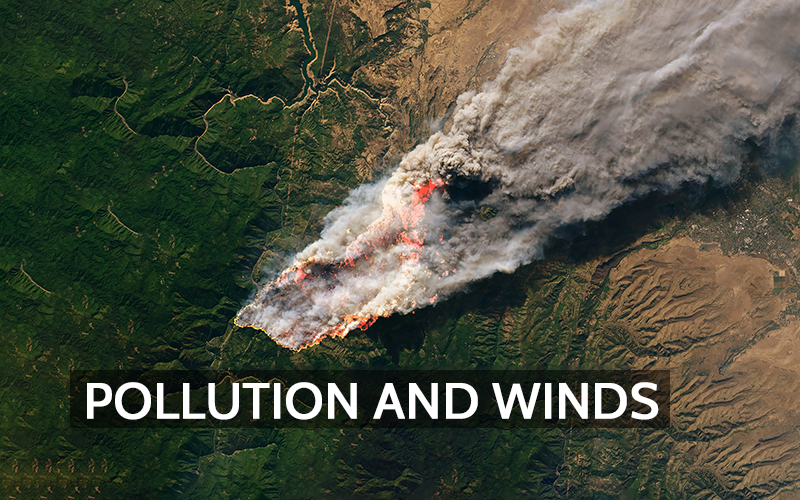Air pollution is a global challenge, with pollutants like particulate matter and harmful gases carried far from their origins by prevailing winds. This phenomenon shows that pollution knows no boundaries. Emissions produced in one location can travel vast distances, affecting air quality for communities far downwind.
The Role of Prevailing Winds in Long-Range Pollution
Prevailing winds act as a conveyor belt, transporting pollutants across landscapes and even oceans. These winds are consistent airflows that follow set directions based on regional patterns. For example, westerly winds in the mid-latitudes often carry pollutants eastward, affecting areas hundreds or thousands of miles away from the pollution’s source. This is evident when smoke from wildfires in the western United States travels as far as the East Coast, resulting in hazy skies and air quality warnings thousands of miles away from the source.
Pollution Beyond Borders: Consequences for Neighboring Regions
The ability of pollutants to travel long distances brings significant health and environmental consequences. Pollution generated in one country can increase health risks, like respiratory issues and cardiovascular diseases, in neighboring or downwind regions. Countries downwind may find it difficult to meet air quality standards due to cross-border pollution as pollutants transported by winds combine with local emissions. This scenario is particularly challenging for countries or states near heavy emitters, as they must manage air quality impacts created by external sources as well as their own emissions.
Types of Pollutants Carried by Winds
Various pollutants are transported by winds, including particulate matter, nitrogen oxides, and sulfur dioxide. Wildfire smoke, for example, consists of fine particles that remain suspended in the atmosphere, traveling over long distances. Dust storms also exemplify this process; fine desert dust from regions like the Sahara can be carried across the Atlantic Ocean, impacting air quality in the Americas. Additionally, industrial emissions of sulfur and nitrogen compounds undergo chemical reactions in the atmosphere, forming secondary pollutants like ground-level ozone and particulate matter, which are then carried over state or national borders.
Atmospheric Conditions That Influence Pollution Dispersion
The extent to which air pollution travels is influenced by atmospheric conditions. Wind speed, direction, and vertical mixing heights (the altitude at which air pollutants can rise and disperse) all play a role in how and where pollutants spread. During stable atmospheric conditions, pollutants may remain near the surface, creating high concentrations in a localized area. However, when winds increase and mixing heights rise, pollutants can disperse vertically and travel farther horizontally, affecting regions downwind.
Temperature inversions, where a layer of warm air traps cooler air and pollutants below it, further complicate pollution dispersion. These inversions can prevent pollutants from rising, keeping them concentrated at ground level and worsening air quality in affected areas. Geography also impacts how pollution moves. Mountain ranges can trap pollutants in valleys, intensifying local air quality issues even as winds continue to carry pollutants to other regions.
Global Responsibility and Mitigation Efforts
The transboundary nature of air pollution highlights the need for collaborative mitigation efforts. Since pollution originating in one area can affect multiple regions, reducing emissions globally benefits everyone. Countries are increasingly cooperating to address cross-border air pollution through agreements that limit emissions of key pollutants. The Clean Air Act in the United States, for example, sets standards aimed at reducing pollutants that contribute to downwind air quality problems.
By understanding how winds transport air pollution, nations can better coordinate efforts to manage emissions and improve air quality. This awareness also supports the development of monitoring systems that track pollution sources, enabling policymakers to make informed decisions that protect public health and the environment across borders.
Air pollution, driven by prevailing winds, shows how environmental issues transcend borders, affecting air quality and public health far from the pollution source. As pollutants travel with the wind, they create challenges for communities and governments striving to maintain clean air. Recognizing the far-reaching impacts of pollution calls for shared responsibility and commitment to sustainable practices that safeguard air quality for all, regardless of geographic location.
Related Article:
Air Quality Regulation and Standards in the United States: Addressing The Gaps
References:
- https://www.epa.gov/international-cooperation/transboundary-air-pollution
- https://naei.energysecurity.gov.uk/transboundary-air-pollution
- https://eur-lex.europa.eu/EN/legal-content/summary/geneva-convention-on-long-range-transboundary-air-pollution.html
- https://www.canada.ca/en/environment-climate-change/services/air-pollution/issues/transboundary/overview.html


